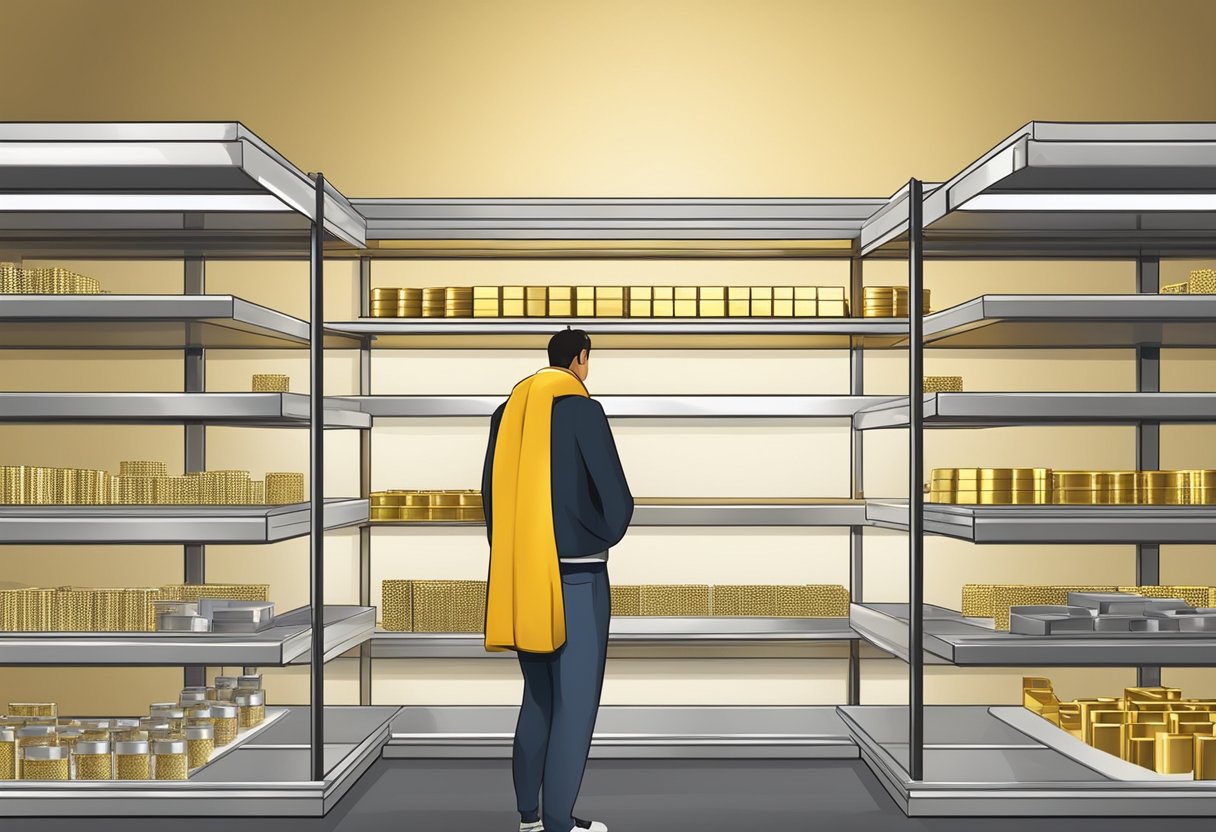Gold & Silver Supply Shortage: Is It Imminent?

Gold and silver have long been considered safe-haven assets, particularly during times of economic uncertainty or inflation. However, recent market developments suggest that a potential supply shortage may be on the horizon, causing concern among investors and industry experts alike. The question on many people’s minds is whether a gold and silver supply shortage is imminent, and what the implications of such a shortage could be.

The current state of the gold and silver markets is somewhat complex. While prices have been relatively stable over the past few years, demand for these precious metals has been steadily increasing. At the same time, mining production has been on the decline, due in part to the high cost of extracting gold and silver from the earth. This has led to a situation where the supply of gold and silver is not keeping pace with demand, which could potentially lead to a supply shortage in the near future.
Factors contributing to a potential supply shortage include a variety of economic and geopolitical factors. For example, rising tensions between major world powers could lead to disruptions in the supply chain for precious metals, while economic instability in certain regions could lead to increased demand for gold and silver as a hedge against inflation. Additionally, mining companies are facing increasing pressure to reduce their environmental impact, which could limit future production levels. All of these factors, and more, are contributing to a sense of uncertainty around the future of gold and silver supply.
Key Takeaways
- Demand for gold and silver is increasing while mining production is declining, potentially leading to a supply shortage.
- Economic and geopolitical factors, as well as environmental concerns, are contributing to uncertainty around the future of gold and silver supply.
- A supply shortage could have significant implications for the global economy and the value of these precious metals.
Current State of Gold and Silver Markets

Price Fluctuations and Investment Trends
The prices of gold and silver have been fluctuating in recent years, with investors closely monitoring the markets for signs of a trend. The price of gold has been on a steady rise since 2015, while the price of silver has been more volatile, reaching a peak in 2016 before declining in 2018 and 2019. Despite this volatility, both metals have remained popular investments for those seeking a safe haven for their assets.
Investors have been closely watching the markets for signs of a trend. While some believe that the prices of gold and silver will continue to rise, others are more cautious. Some investors are wary of the potential for a bubble, while others believe that the true prices of these precious metals have yet to be realized.
Physical Demand vs. Paper Game
One of the key factors influencing the price of gold and silver is the balance between physical demand and the paper game. Physical demand refers to the actual demand for the physical metals themselves, while the paper game refers to the trading of gold and silver futures contracts.
In recent years, there has been a growing concern that the paper game is distorting the true prices of gold and silver. Some investors believe that the paper game has created an artificial supply of these metals, leading to a potential supply shortage in the future.
Despite these concerns, the physical demand for gold and silver remains strong. Many investors continue to hold physical metals as a hedge against economic uncertainty and inflation. As such, the supply of physical metals remains a key factor in determining the true prices of gold and silver.
Overall, the current state of the gold and silver markets is complex and subject to a range of factors. While some investors remain bullish on these metals, others are more cautious. The balance between physical demand and the paper game will likely continue to influence the prices of gold and silver in the years to come.
Factors Contributing to Supply Shortage

Mining Industry Challenges
The mining industry faces a number of challenges that are contributing to a potential supply shortage of gold and silver. One of the major challenges is the declining ore grades of existing mines. As the quality of ore decreases, it becomes more difficult and expensive to extract precious metals, leading to a slowdown in production. In addition, mining companies are facing increased pressure from environmental regulations, making it harder to obtain permits and operate mines.
Economic Downturn and Its Impact
The economic downturn of recent years has had a significant impact on the supply of gold and silver. As the global economy slows down, demand for precious metals decreases, leading to a decrease in production by mining companies. This, coupled with the high cost of mining, has led to a reduction in the number of new mines being opened, further exacerbating the supply shortage.
Increasing Industrial Demand
The increasing demand for precious metals in various industries, such as electronics and solar panel production, is also contributing to the supply shortage. As demand for base metals like copper and zinc increases, so does the demand for gold and silver, which are often used in small quantities in these industries. This increased demand is putting pressure on existing supplies, leading to higher prices and potential shortages.
To sum it up, a combination of declining ore grades, environmental regulations, economic downturn, and increasing industrial demand are all contributing to a potential supply shortage of gold and silver. As demand continues to rise, it is important for the mining industry to find new ways to increase production and meet the needs of various industries while also addressing environmental concerns.
Implications of a Supply Shortage
A supply shortage of gold and silver can have significant implications for the precious metals industry, investors, and the broader economy. This section explores the effects of a supply shortage and the potential for a sound money movement.
Effects on Prices and Investors
A supply shortage of gold and silver can lead to a significant increase in prices due to the law of supply and demand. As the supply of these precious metals dwindles, investors may rush to purchase them, driving up the prices even further. This can make gold and silver a valuable hedge against inflation, as they tend to retain their value even when other assets lose value.
Investors who hold gold and silver may benefit from a supply shortage, as their holdings may increase in value. However, investors who are looking to purchase these metals may face higher prices and limited availability.
Potential for a Sound Money Movement
A supply shortage of gold and silver may also lead to a renewed interest in sound money, which refers to currencies that are backed by precious metals. Proponents of sound money argue that it can help protect against inflation and provide a stable store of value.
A supply shortage of gold and silver may lead to increased demand for sound money, as investors look for alternative ways to protect their wealth. This could lead to a broader movement towards sound money, which could have implications for the broader economy.
In conclusion, a supply shortage of gold and silver can have significant implications for the precious metals industry, investors, and the broader economy. While it may lead to higher prices and limited availability, it may also lead to a renewed interest in sound money and alternative ways of protecting wealth.
Expert Insights and Future Outlook
Analysis by Industry Experts
According to industry experts, the global supply of gold and silver is likely to experience a shortage in the near future. Andrew Maguire, a renowned precious metals expert and founder of “Live from the Vault,” has predicted that the demand for physical gold and silver will outstrip supply, leading to a significant price increase.
Rob Kientz, the founder of GoldSilverPros, echoes this sentiment, stating that the current market conditions are ripe for a supply squeeze. He believes that the combination of rising demand and limited supply will drive prices higher, making gold and silver an attractive investment option.
Prospects for Silver and Gold
The Prospector and Developer Association of Canada (PDAC) recently held a major industry event where experts discussed the future prospects for gold and silver. The consensus among the panelists was that the outlook for both metals is positive, with demand expected to increase in the coming years.
Trade Secrets, a leading provider of market analysis and insights, has also released a report stating that the global supply of gold and silver is likely to remain tight in the foreseeable future. The report cites several factors, including declining mine production, increasing geopolitical tensions, and rising investor demand.
While the exact timing and extent of the supply shortage remain uncertain, it is clear that gold and silver are poised for significant price increases in the coming years. This information is for informational purposes only and should not be taken as investment advice.
Overall, industry experts are confident that the current market conditions will lead to a supply squeeze for gold and silver. Investors looking to capitalize on this trend should consider adding these precious metals to their portfolios.







